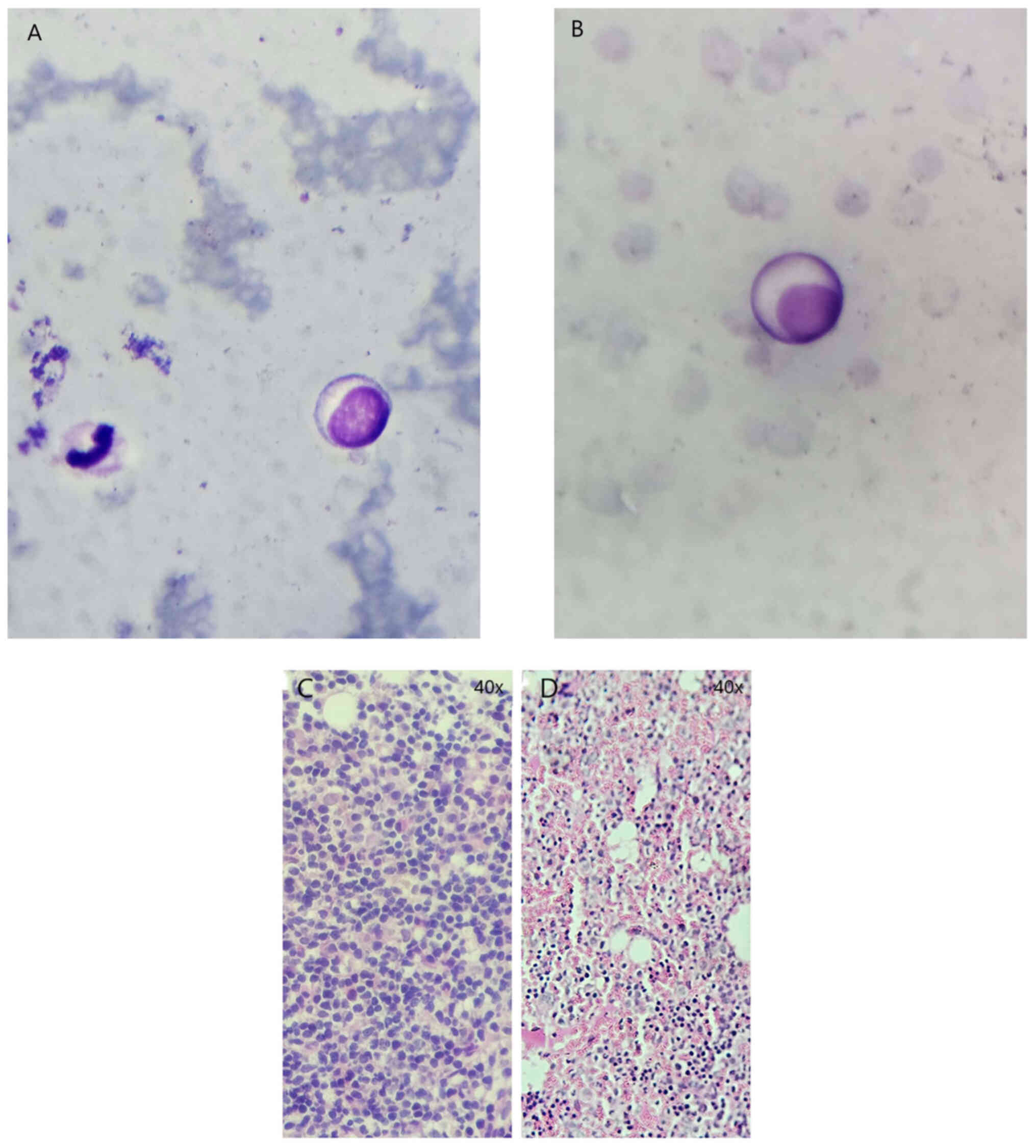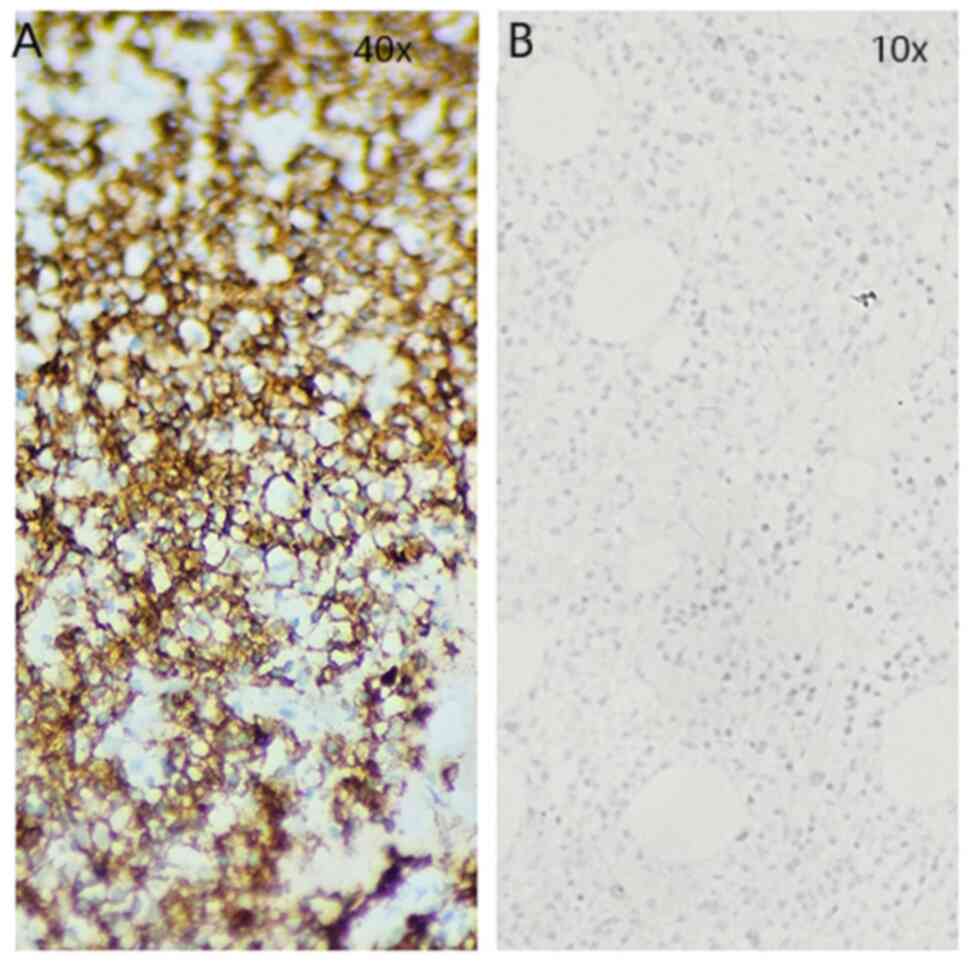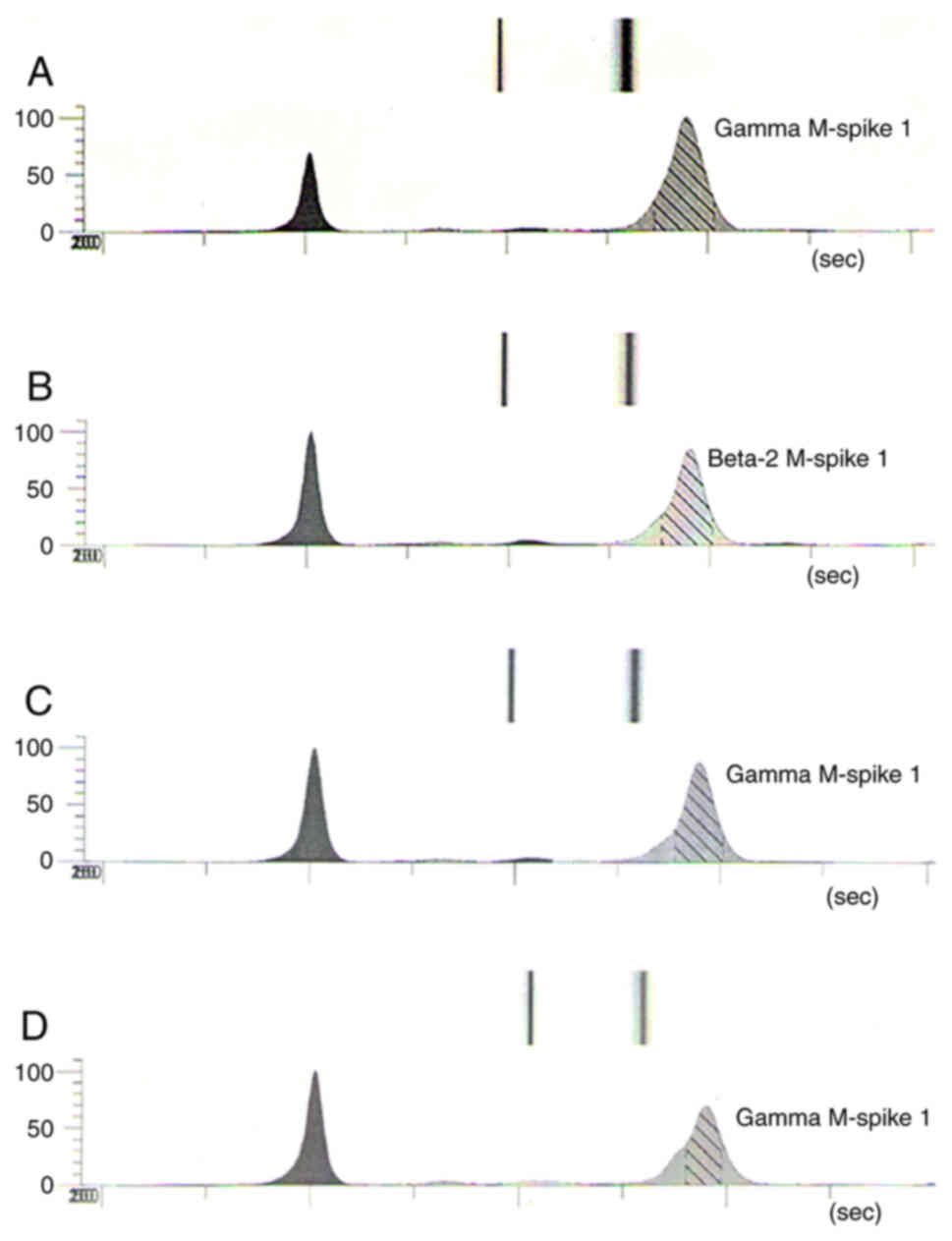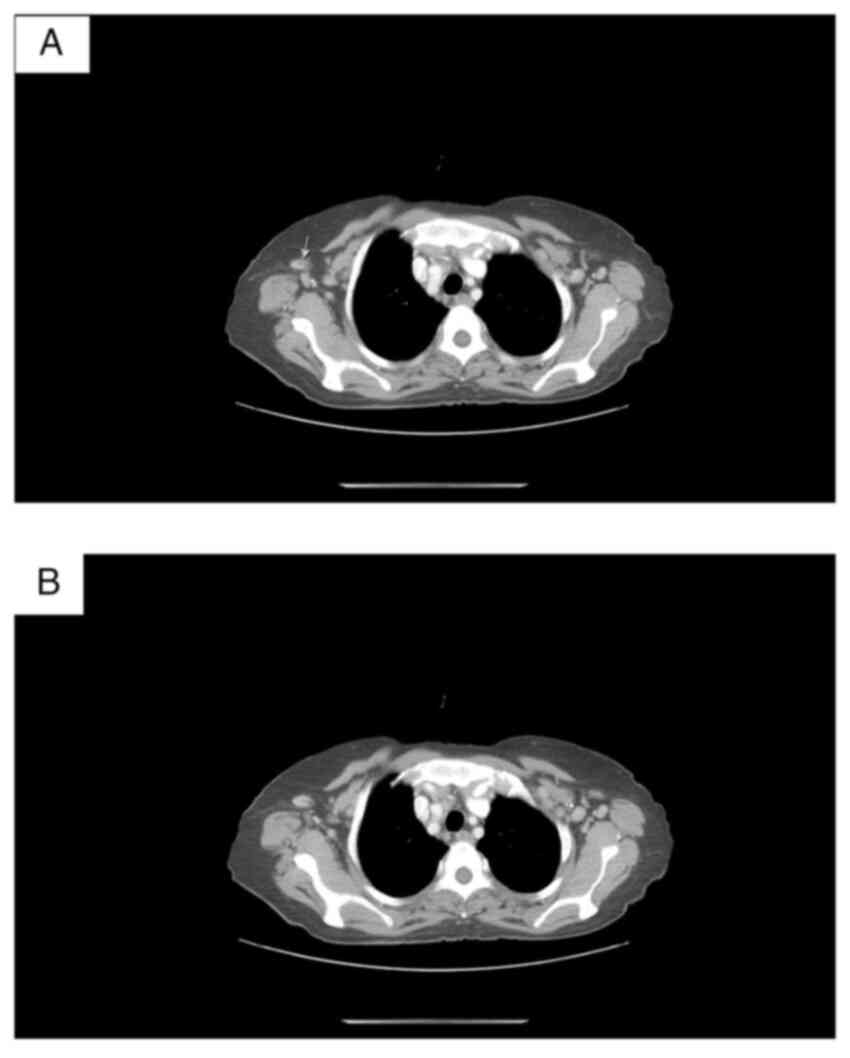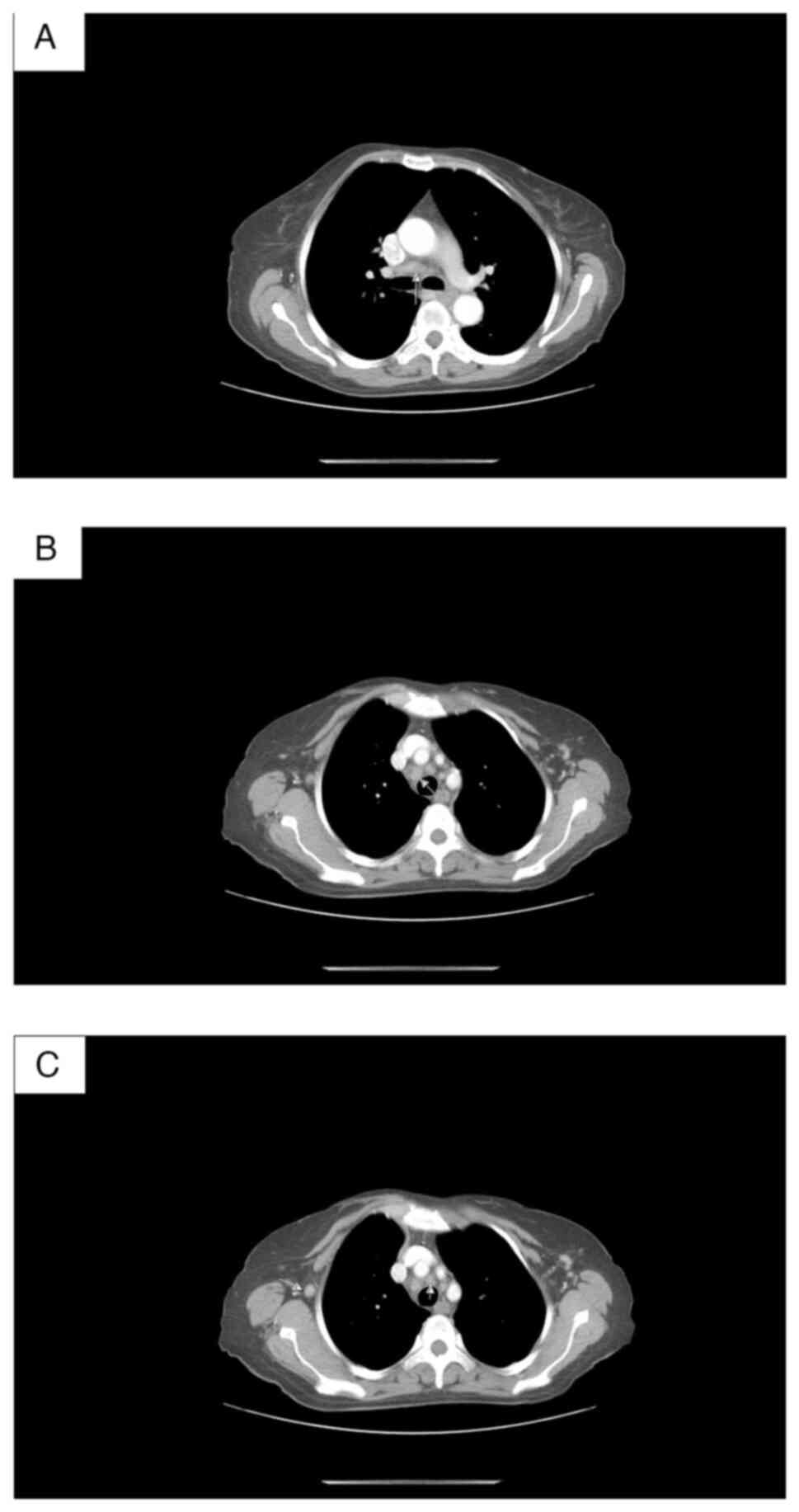Good clinical response following Ibrutinib treatment of a rare case of lymphoplasmacytic lymphoma secreting IgA kappa paraprotein: A case report
- Authors:
- Published online on: May 28, 2024 https://doi.org/10.3892/ol.2024.14471
- Article Number: 338
-
Copyright: © Nikolova et al. This is an open access article distributed under the terms of Creative Commons Attribution License.
Abstract
Introduction
Lymphoplasmacytic lymphoma (LPL) is a rare low-grade non-Hodgkin lymphoma which affects the B-lymphocytes and causes their abnormal growth and dysregulation (1). The abnormal B-cells show features of both lymphocytes and plasma cells, hence originates the name of the disease. Most patients have the clinical syndrome of Waldenström macroglobulinemia (WM), which is defined as LPL with an associated immunoglobulin M (IgM) serum monoclonal protein. Roughly 5% of LPL patients secrete non-IgM paraproteins (e.g., IgG, IgA, kappa, lambda) or are non-secretory (2).
Due to its extreme rarity (only 5% of all LPL cases), non-IgM LPL is challenging to diagnose and, also, to treat and cure. Moreover, those rare cases usually present with a heterogeneous clinical phenotype and there is generally a lack of reported cases. To the best of our knowledge, this is the second non-IgM LPL case reported in scientific literature with kappa chain production (3). Before that, Cautha et al (2) reported a case of a non-IgM LPL with lambda light chain monoclonal paraprotein expression. In addition, it was presented how the management strategy was modified from the time of diagnosis until the patient finally benefitted from a treatment using a Bruton TK inhibitor (Ibrutinib). This case will be useful in hematological practice to shorten the time of diagnosis of such complicated and rare cases and to suggest the most beneficial treatment protocol.
Case report
А 62-year-old female patient was accepted initially in a regional hospital (September 2022; Hospital ‘St. George’, Plovdiv, Bulgaria) suspected with a plasma cell neoplasia (PCN). At that time, flow cytometry of the bone marrow revealed that 75% of the lymphocytes had phenotype as CD19+/CD20+/CD79b/CD5−/CD200−/CD23-/CD10−/CD43−. In total, 16% of the lymphocytes belonged to T-subtype (CD3+), 11% were Th cells (CD3+CD46) and 4.55% were Tc (CD3+CD8+). The ratio Th/Tc was 2.2; 2.31% were NK cells (CD3−CD56+CD16+) and 2% of the cells in the aspirate were plasma cells with a phenotype CD38+/CD138+/CD19+/−/CD45+/CD56 kappa+. As those results were suspected for B-cell lymphoma kappa (+), a molecular genetic analysis was recommended. PCR analysis followed by 2% agarose gel electrophoresis with ethidium bromide revealed a carriership of a somatic mutation L265P in MYD88 gene. The flow cytometric and molecular-genetic analyses were performed before the admission of the patient to our clinic, and thus, the presented results were retrieved from the official medical records, which is one of the limitations of the present study.
Trepanobiopsy showed cells typical for LPL, bearing marks both of lymphocytes and plasma cells (Fig. 1A and B). Staining of the bone marrow sample revealed a massive infiltration by lymphoplasmacytic cell populations (Fig. 1C). The subsequent staining for markers CD138 (Fig. 2A) and CD20 (Fig. 3A) was positive. A substantial part of the analyzed cells were Pax5-positive (a nuclear marker of mature B cells), CD5 staining was positive only in a small amount of dispersed lymphoids, and CD56 staining was positive in osteoclasts and osteoblasts. MUM1 (a marker of a transition of mature B cells towards plasma cells) was also expressed in a part of the cell content; moderate fibrosis was detected (stage MF-2). The subsequent agarose gel electrophoresis demonstrated a presence of M gradient. The staining data were taken directly from the medical records of the patient. An initial therapy was initiated by one course of Bendamustine/Rituximab. The treatment provoked a reaction of general kidney failure and anuria and the patient was accepted at the Nephrology department for treatment.
Later on, upon a reason of her kidney problems, the patient decided to seek a second opinion and referred to the Hematology ward of the University Hospital ‘St. Ivan Rilski’ where she had been admitted. She was assigned additional testing, including serum isoelectric focusing (IEF), which demonstrated a distinct amount of paraprotein in the serum type IgA/kappa (Gamma M-spike 63.97 g/l, KF 119.94 mg/l) (Fig. 4A) and myelogram that reported cytological data for LPL with moderate and expressed hypoplasia of the bone marrow (54% lymphoplasmocytes). Computed tomography (CT) demonstrated rounded cervical lymph nodes with maximum axial dimensions 8.8/8.5 mm; axial lymph nodes bilaterally [dimensions: 13.5/11 mm from the left side and 15/11 mm from the right (Fig. 5)]. No pleural effusion was visualized. Тhe trachea had lumen of normal width and wall thickness. The bronchi bilaterally were freely passable up to the segmental level. No infiltrative changes or nodular lesions were visualized in the lung parenchyma. CT data of enlarged mediastinal lymph nodes with axial size 27/13 mm (Fig. 6). Тhere were no focal lesions in the structure of the liver and the spleen; adrenal glands and both kidneys were intact. CT data for axillar, mediastinal, abdominal (Fig. 7C), pelvic and inguinal lymphadenopathy (Fig. 7A and B). The diagnosis of LPL IV B clinical stage, stage D LPL was confirmed. The treatment was based on NCCN clinical practice guidelines in oncology (4) and the patient was assigned three more courses of Bendamustine/Rituximab (from November of 2022 to January of 2023). At that stage, the patient decided to continue her treatment and follow up at the University Hospital.
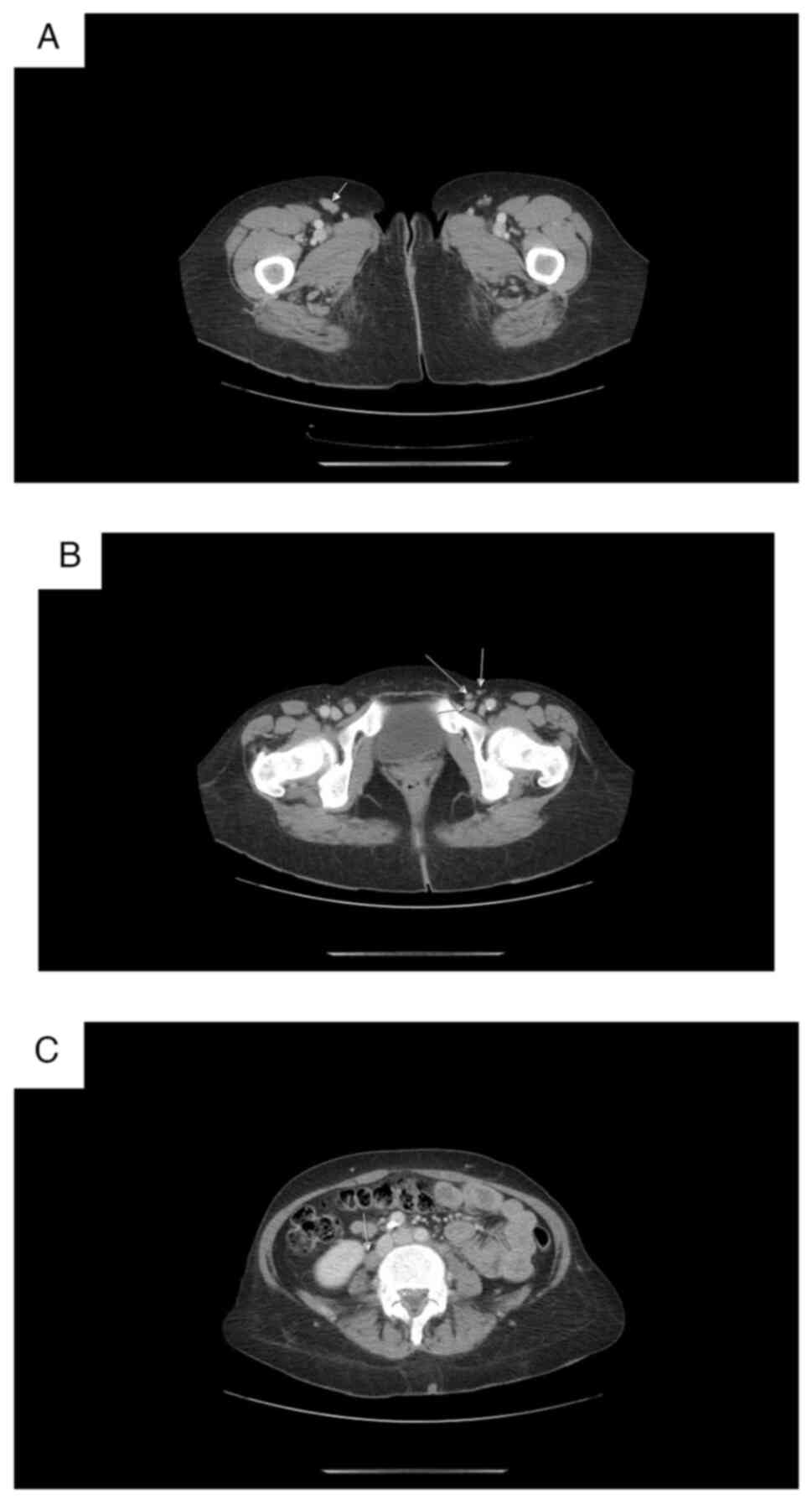 | Figure 7.Computer tomography images indicating (A and B) inguinal and (C) abdominal lymphadenopathy. |
In February 2023, the patient was accepted again for control examinations and re-assessment of the treatment. Trepanobiopsy provided evidence of partial response (PR) to the treatment. IEF confirmed the decrease in the paraprotein type IgA/K-Gamma M-spike in the serum 44.57 g/l (Fig. 4B). Even if there was a partial reduction, the plasma cell populations were again stained positive (Fig. 1D). The lymphoplasmocytes still accounted for >50% of the cell contents (Fig. 2B), indicating that the level of plasma cell populations in the bone marrow was still high. There was a complete lack of cells expressing CD20 (Fig. 3B). The results from the WBC are included in Table I.
Table I.Whole blood count of the patient upon her acceptance in the Hematology ward of ‘St. Ivan Rilski’ University hospital. |
Following the PR to the treatment, it was decided to continue on the same regimen for another 2 courses of immuno-chemotherapy. The patient's treatment course included Rituximab 600 mg at day 1, Bendamustine 100 mg at days 2 and 3, dexamethasone 20 mg/day for 4 days, Fraxiparine 0.4 mg/day and additional drugs for her high blood pressure and kidney failure.
After 6 courses in total with Bendamustine/Riuximab, the patient was evaluated again with serum IEF exhibiting a persistence of paraprotein type IgA/kappa in the serum (Gamma M-spike 44.57 g/l, KF 39.74 mg/l) (Fig. 4C). From April 2023 she started therapy with Bruton kinase inhibitor [Ibrutinib (brand name, Imbruvica)]-3 tablets/day (total 420 mg/day).
The last control examinations of the patient dated from August 2023. After four months of treatment with Imbruvica, she had substantially improved her health condition (Table II) and had lowered the level of IgA with ~30 g (from October 2022 until July 2023). The serum electrophoresis reported Gamma M-spike concentration of 29.27 mg/l (Fig. 4D). Currently the patient is feeling well; her ECOG PS performance status is 1, as of December 2023. The patient's blood examinations revealed mild anemia (HGB, 109 g/l), neutropenia (Neu, 1.01 g/l) and the biochemical results revealed slightly elevated levels of total protein 87.8 g/l (normal range 64–83 g/l). Her condition is continued to be monitored by regular IEF of blood and urine samples.
Table II.Whole blood count (WBC) of the patient after her discharge from the Hematology ward of ‘St. Ivan Rilski’ University hospital (at her last control examination). |
Discussion
WM is a term indicating LPL with an associated immunoglobulin M (IgM) serum monoclonal protein (5). LPL, associated with IgA paraprotein is even more rare and those cases mimic a plasma cell neoplasm (PCN) (6). In a study of 27 cases with either IgA or IgG secretion, Qiu et al (6) reported that all patients had a median bone marrow involvement of 10%, light chain was identified in 96% of the cases measured by flow cytometry, while MYD88 mutation was detected in 17 of 24 cases (71%). The neoplastic plasma cells were positive for CD45 (100%), CD19 (96%), CD81 (89%), CD27 (83%), CD56 (16%), whereas CD117 was consistently negative (6). As differential diagnostic features of LPL over PCN, the authors point the characteristic immunophenotypic profile and the presence of MYD88 and/or CXCR4 mutations. In a study comparing non-IgM LPL cases and WM controls matched by age and sex, the presence of extramedullary disease was higher in cases, while neuropathy and hyperviscosity was higher in controls (7). A recent study using next-generation sequencing approach reported MYD88 to be the most common mutation in non-IgM LPL patients (70%), followed by CXCR4 (20%), KMT2D (10%) and ARID1A (10%). Mutant allele frequency in MYD88 L265P did not differ significantly between WM and non-IgM-type LPL. Most mutations detected by NGS were subclonal following MYD88 L265P. Those results proved similar genetic characteristics in the two subsets of LPL patients (8).
Nearly 90% of IgM secreting LPL develop a somatic mutation in the gene MYD88, and even rarer, in CXCR4 (1). MYD88 is a driver gene in hematologic B-cell malignancies and the missense mutation (L265P) is a single causative mutation transforming IgM-producing B cells into malignant B cells (9). It constitutively activates NF-κB and its associated signaling pathways, thereby promoting B-cell proliferation and survival (10). It is a missense gain-of-function mutation in myeloid differentiation changing the amino-acid leucine to proline at position 265 of MYD88 (11). MYD88 is playing the role of an adaptor molecule in the canonical NF-κB pathway coordinating the assembly of a multisubunit complex of IRAK1 and IRAK4 (IL-1 receptor-associated kinases), which through TRAF6, activate TAK1 (TGFβ-activated kinase 1). The activated NF-κB increases signaling of IL-6 and IL-10, which further promotes B-cell proliferation and survival via JAK/STAT signaling cascade (10).
MYD88 L265P is a somatic mutation (9,12) identified in ~90% of WM, but the demonstration of this mutation is also a necessary tool for the right WHO diagnosis of LPL (12,13). It is usually found in blood and/or the bone marrow. However, there are unusual places of its expression, as the skin in cutaneous form of WM (14). MYD88 L265P is usually used to discriminate WM and non-IgM LPL from other B-cell disorders (15). However, there are several studies discussing the potential of the mutation as a prognostic biomarker. It was previously revealed that MYD88 expression was an independent prognostic factor affecting overall survival in diffuse large B cell lymphoma (16,17). It was positively correlated with high Ki-67 expression and promotes tumor proliferation (17). Pham-Ledard et al (18) reported that MYD88 L265P was associated with a poorer outcome of patients with large B-cell lymphoma. Previous studies could not engage with a statement about the prognostic impact of the mutation (19,20). In LPL/WM, there is no consensus about the role of MYD88 L265P as prognostic biomarker. LPL/WM patients harboring the MYD88 L265P mutation show clues of longer survival compared with wild-type cases (21). In IgM-secreted monoclonal gammopathies, the mutation behaves like an adverse risk factor and exhibits a 5-fold increased risk of progression to LPL/WM (22). According to other authors, the identification of the MYD88 L265P gene mutation represented a major advance in the diagnosis of LPL (3,13). Rossi (23) stated that the presence of this mutation is just an indicative of a more accurate diagnosis of LPL and maybe just accompanies the tumor burden on predicting the disease progression. Cautha et al (2) reported a non-IgM rare case of LPL with lambda light chain paraprotein expression positive for MYD88 L265P mutation. It was stated that non-IgM LPL has a poorer outcome yet does not infer the prognosis to the mutational presence (2). In the present study, the patient shows a favorable recovery yet, according to the authors, this is rather due to the treatment strategy than to the prognostic indication of MYD88 L265P mutation.
Major clinical complications of non-IgM-secreting LPL have been described as anemia associated symptom (53.8%), mucocutaneous hemorrhage and superficial lymphadenopathy (15.4%). At the same time, clinical and biological differences between non-IgM LPL and WM have not been identified (24). One of the serious complications associated with high levels of paraproteins in patients with hematological malignancies is the hyperviscosity syndrome (HVS). It is demonstrated by symptoms, including nosebleeds, blurring vision, dizziness, headaches and shortness of breath (1). The treatment of WM (IgM LPL) mainly aims to monitor the disease and keep it under stable control. In case of serious symptoms, HVS or deviations from the normal blood indicators (anemia, neutropenia or thrombocytopenia), the usual starting treatment consists of a combination of a chemotherapeutic and an antibody (Rituximab). The common regimens include either DRC (Dexamethasone, Rituximab and Cyclophosphamide) or Benda-R (Bendamustine and Rituximab). In the current presented case, the second treatment option was preferably used. In some cases, Bruton tyrosine kinase (BTK) inhibitors or proteasome inhibitors give promising results but in specific circumstances (relapsed lymphoma or lack of response to previous treatment). When trying to discriminate non-IgM LPL and WM, there were no discovered differences in both response and overall survival and they are similar between the two groups (7). However, a study from 2018 in Korean patients, reported that patients with non-IgM LPL demonstrated a higher 5-year mortality rate and more adverse prognostic factors than those with LPL/WM (25). Another study of non-WM LPL cases identified the most common paraprotein being IgG (54%), followed by IgA (15%) and non-secretory (12%). The authors reported more adverse prognostic factors such as elevated LDH, anaemia and lymphocytosis at diagnosis but no difference in overall survival (26). As the combination of Bendamustine and Rituximab in the present case did not produce the desired effect, Ibrutinib (IMBRUVICA®) was included in the treatment protocol.
Ibrutinib has been approved in combination with Rituximab for the treatment of adults with WM in 2018. From that moment on, several studies reported the overall efficacy of Ibrutinib treatment. In a study of 2017, Helber et al (27) reported the clinical effect of Ibrutinib on 23 patients with LPL (most with IgM and one with IgG secretion). The median maximum IgM decrease was 67%, as for IgG-the decrease was 37%. It was underlined that the response to Ibrutinib requires long-term continuation of treatment in most of the patients (27). According to the approved therapeutic indications of the drug, it is recommended for the treatment of elderly patients with CLL (in combination with Bendamustine and Rituximab) who have received at least one preceding therapy or for patients with WM (in combination with Rituximab). In a previously reported case of non-IgM LPL and lambda light chain expression, the authors reported that, even in case of an initial response, the treatment of Ibrutinib and Rituximab did not lead to an improve (the patient succumbed after 8 months of diagnosis) (2). To the best of the authors' knowledge, there is only one more case in literature, reporting the usage of Ibrutinib in a refractory IgA LPL carrying MYD88 L265P gene mutation (3). In the cited study, the patient benefited from Ibrutinib treatment for a period of 4–6 weeks following treatment and the PR was maintained for ~1 year of therapy. Therefore, the present case is the second reported kappa positive LPL case positively influenced by Ibrutinib treatment and the response was detected at the fourth month following treatment. In the current case, the patient showed a substantial improvement in her condition and the level of the IgA paraprotein was decreased ~50% after four months of treatment with the triple combination (Bendamustine, Rituximab and Ibrutinib). Therefore, the reported data confirms previously reported single observations and adds a relevant knowledge to those challenging-to-diagnose and rare cases of non-IgM IgA kappa secreting LPLs.
In conclusion, the case presented by our team describes a very rare hematological malignancy; IgA-secreted LPL resembling PCN. The processes of the disease diagnosis and treatment were reported, highlighting the effectiveness of the triple treatment protocol (Benda-R plus BTK) in the patient of the present case report. Regardless of the observed improvement, there is a necessity for a long-term monitoring of the patient condition to prove the suitability of the selected treatment option.
Acknowledgements
Not applicable.
Funding
Funding: No funding was received.
Availability of data and materials
The data generated in the present study may be requested from the corresponding author.
Authors' contributions
DN designed the study, analyzed and interpreted the data, and drafted the manuscript. AY, LS and AM acquired the data and participated in the analysis. DN, AR and AM interpreted the data. AR critically revised the manuscript and made final suggestions. AY, AM, LS and AR treated and cared for the patient. AY and AR confirm the authenticity of all the raw data. All authors read and approved the final version of the manuscript.
Ethics approval and consent to participate
Not applicable.
Patient consent for publication
The patient provided written informed consent upon admission to the University Hospital ‘St. Ivan Rilski’ for publication of the data and associated images.
Competing interests
The authors declare that they have no competing interests.
Glossary
Abbreviations
Abbreviations:
|
LPL |
lymphoplasmacytic lymphoma |
|
WM |
Waldenström macroglobulinemia |
|
WBC |
whole blood count |
|
PR |
partial response |
|
PCN |
plasma cell neoplasia |
References
|
Lymphoma Action: Lymphoplasmacytic lymphoma and Waldenström's macroglobulinaemia. Lymphoma Action, Bucks. 2022.https://lymphoma-action.org.uk/types-lymphoma-non-hodgkin-lymphoma/lymphoplasmacytic-lymphoma-and-waldenstroms-macroglobulinaemia#symptoms | |
|
Cautha S, Gupta S, Hanif A, Moirangthem V and Jain K: Lymphoplasmacytic lymphoma with only lambda light chain monoclonal paraprotein expression. Eur J Case Rep Intern Med. 9:0031062022.PubMed/NCBI | |
|
Quaglia FM, Rigolin GM, Saccenti E, Negrini M, Volta E, Dabusti M, Ciccone M, Urso A, Laudisi M and Cuneo A: Response to Ibrutinib of a refractory IgA lymphoplasmacytic lymphoma carrying the MYD88 L265P gene mutation. Mediterr J Hematol Infect Dis. 11:e20190572019. View Article : Google Scholar : PubMed/NCBI | |
|
Kumar SK, Callander NS, Adekola K, Anderson LD Jr, Baljevic M, Baz R, Campagnaro E, Castillo JJ, Costello C, D'Angelo C, et al: Waldenström macroglobulinemia/lymphoplasmacytic lymphoma, version 2.2024, NCCN clinical practice guidelines in oncology. J Natl Compr Canc Netw. 22((1D)): e2400012024.PubMed/NCBI | |
|
Swerdlow SH, Campo E, Pileri SA, Harris NL, Stein H, Siebert R, Advani R, Ghielmini M, Salles GA, Zelenetz AD and Jaffe ES: The 2016 revision of the World Health Organization classification of lymphoid neoplasms. Blood. 127:2375–2390. 2016. View Article : Google Scholar : PubMed/NCBI | |
|
Qiu L, Nwogbo OV, Medeiros LJ, Thakral B, Li S, Xu J, You MJ, Wang W, Quesada AE, Ramos CB, et al: Lymphoplasmacytic lymphoma with IgG or IgA paraprotein: A study of 29 cases including cases that can mimic plasma cell neoplasms. Hum Pathol. 130:47–57. 2022. View Article : Google Scholar : PubMed/NCBI | |
|
Castillo JJ, Itchaki G, Gustine JN, Meid K, Flynn CA, Demos MG, Guerrera ML, Jimenez C, Kofides A, Liu X, et al: A matched case-control study comparing features, treatment and outcomes between patients with non-IgM lymphoplasmacytic lymphoma and Waldenström macroglobulinemia. Leuk Lymphoma. 61:1388–1394. 2020. View Article : Google Scholar : PubMed/NCBI | |
|
Awata-Shiraiwa M, Yokohama A, Kanai Y, Gotoh N, Kasamatsu T, Handa H, Saitoh T, Murakami H, Hirato J, Ikota H and Tsukamoto N: Waldenstrom macroglobulinemia and non-IgM-type lymphoplasmacytic lymphoma are genetically similar. Acta Haematol. 146:384–390. 2023. View Article : Google Scholar : PubMed/NCBI | |
|
Yu X, Li W, Deng Q, Li L, Hsi ED, Young KH, Zhang M and Li Y: MYD88 L265P mutation in lymphoid malignancies. Cancer Res. 78:2457–2462. 2018. View Article : Google Scholar : PubMed/NCBI | |
|
de Groen RAL, Schrader AMR, Kersten MJ, Pals ST and Vermaat JSP: MYD88 in the driver's seat of B-cell lymphomagenesis: From molecular mechanisms to clinical implications. Haematologica. 104:2337–2348. 2019. View Article : Google Scholar : PubMed/NCBI | |
|
Ngo VN, Young RM, Schmitz R, Jhavar S, Xiao W, Lim KH, Kohlhammer H, Xu W, Yang Y, Zhao H, et al: Oncogenically active MYD88 mutations in human lymphoma. Nature. 470:115–119. 2011. View Article : Google Scholar : PubMed/NCBI | |
|
Martinez-Lopez A, Curiel-Olmo S, Mollejo M, Cereceda L, Martinez N, Montes-Moreno S, Almaraz C, Revert JB and Piris MA: MYD88 (L265P) somatic mutation in marginal zone B-cell lymphoma. Am J Surg Pathol. 39:644–651. 2015. View Article : Google Scholar : PubMed/NCBI | |
|
Martino G, Marra A, Ascani S and Sportoletti P: Uncommon lymphoplasmacytic lymphoma with IgA paraproteinemia: A challenging clinical diagnosis solved by MYD88 mutation analysis. Ann Hematol. 98:1507–1508. 2019. View Article : Google Scholar : PubMed/NCBI | |
|
Minzenmayer AN, Miranda RN, Powell PR and Parekh PK: An unusual case of cutaneous Waldenström macroglobulinemia with the MYD88 L265P mutation. J Cutan Pathol. 47:850–853. 2020. View Article : Google Scholar : PubMed/NCBI | |
|
Treon SP, Xu L, Yang G, Zhou Y, Liu X, Cao Y, Sheehy P, Manning RJ, Patterson CJ, Tripsas C, et al: MYD88 L265P somatic mutation in Waldenström's macroglobulinemia. N Engl J Med. 367:826–833. 2012. View Article : Google Scholar : PubMed/NCBI | |
|
Fernández-Rodríguez C, Bellosillo B, García-García M, Sánchez-González B, Gimeno E, Vela MC, Serrano S, Besses C and Salar A: MYD88 (L265P) mutation is an independent prognostic factor for outcome in patients with diffuse large B-cell lymphoma. Leukemia. 28:2104–2106. 2014. View Article : Google Scholar : PubMed/NCBI | |
|
Niu J, Ma Z, Nuerlan A, Li S, Cui W, Gao H, Abulajiang G, Zhang W and Li X: Prognostic value of MYD88 L265P mutation in diffuse large B cell lymphoma via droplet digital PCR. Mol Med Rep. 22:1243–1256. 2020. View Article : Google Scholar : PubMed/NCBI | |
|
Pham-Ledard A, Beylot-Barry M, Barbe C, Leduc M, Petrella T, Vergier B, Martinez F, Cappellen D, Merlio JP and Grange F: High frequency and clinical prognostic value of MYD88 L265P mutation in primary cutaneous diffuse large B-cell lymphoma, leg-type. JAMA Dermatol. 150:1173–1179. 2014. View Article : Google Scholar : PubMed/NCBI | |
|
Yu S, Luo H, Pan M, Palomino LA, Song X, Wu P, Huang JM and Zhang Z: High frequency and prognostic value of MYD88 L265P mutation in diffuse large B-cell lymphoma with R-CHOP treatment. Oncol Lett. 15:1707–1715. 2018.PubMed/NCBI | |
|
Lee YS, Liu J, Fricano KA, Webb EM, Toolsie DR, Jones S, Rhoads JA, Vij R, Cashen AF, Abboud CN, et al: Lack of a prognostic impact of the MyD88 L265P mutation for diffuse large B cell lymphoma patients undergoing autologous stem cell transplantation. Biol Blood Marrow Transplant. 23:2199–2204. 2017. View Article : Google Scholar : PubMed/NCBI | |
|
Treon SP, Cao Y, Xu L, Yang G, Liu X and Hunter ZR: Somatic mutations in MYD88 and CXCR4 are determinants of clinical presentation and overall survival in Waldenstrom macroglobulinemia. Blood. 123:2791–2796. 2014. View Article : Google Scholar : PubMed/NCBI | |
|
Varettoni M, Zibellini S, Arcaini L, Boveri E, Rattotti S, Pascutto C, Mangiacavalli S, Gotti M, Pochintesta L, Paulli M and Cazzola M: MYD88 (L265P) mutation is an independent risk factor for progression in patients with IgM monoclonal gammopathy of undetermined significance. Blood. 122:2284–2285. 2013. View Article : Google Scholar : PubMed/NCBI | |
|
Rossi D: Role of MYD88 in lymphoplasmacytic lymphoma diagnosis and pathogenesis. Hematology Am Soc Hematol Educ Program. 2014:113–118. 2014. View Article : Google Scholar : PubMed/NCBI | |
|
Zou D, Yi S, Liu H, Li Z, Lyu R, Liu W, Ru K, Zhang P, Chen H, Qi J, et al: Clinical and biological characteristics of non-IgM lymphoplasmacytic lymphoma. Zhonghua Xue Ye Xue Za Zhi. 36:493–496. 2015.(In Chinese). PubMed/NCBI | |
|
Kang J, Hong JY and Suh C: Clinical features and survival outcomes of patients with lymphoplasmacytic lymphoma, including non-IgM type, in Korea: A single-center experience. Blood Res. 53:189–197. 2018. View Article : Google Scholar : PubMed/NCBI | |
|
Brandefors L, Sander B, Lundqvist K and Kimby E: Clinical characteristic and outcome of lymphoplasmacytic lymphoma of non-Waldenstrom macroglobulinemia type: A Swedish lymphoma registry study. Br J Haematol. 196:1362–1368. 2022. View Article : Google Scholar : PubMed/NCBI | |
|
Helber MJ, Moore JE, Williams AM, Meacham PJ, Rothberg PG and Zent CS: Ibrutinib therapy for lymphoplasmacytic lymphoma. Am J Hematol. 92:E542–E544. 2017. View Article : Google Scholar : PubMed/NCBI |



